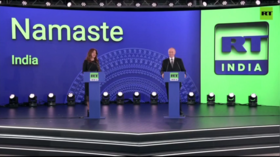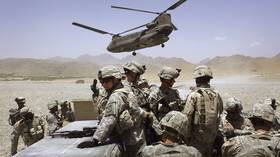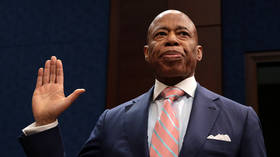Chief Rabbi of Tel Aviv: ‘A Russian boy saved my life at Buchenwald’

Yisrael Meir Lau, the former Chief Rabbi of Israel, and the head of the world’s biggest Holocaust museum, recalls losing most of his family to the Nazis, surviving the horrors of concentration camps, and being rescued from a heap of corpses 70 years ago.
Born in Poland into a family line of rabbis going back more than
1,000 years in 1937, Lau’s earliest memory is seeing his father,
Moshe Chaim, the Chief Rabbi of Piotrkow, being beaten by a
Gestapo officer in the city square, with his congregation looking
on.
“This is the first picture I remember, because as a child,
your father is the hero of the city, of the whole community, and
of course of the family, and he’s almost falling in the eyes of
all the community. This is a picture I cannot forget,” he
recalled in a sit-down interview with RT’s Sophie Shevarnadze.
Piotrkow was major hub for Poland’s Jews and the Nazis set up a
ghetto there, but by 1941 Hitler opted for the Final Solution.
Lau remembers being called to the Synagogue, where names of those
who would be allowed to go back to their houses were read out.
Those not on the list had to stay behind. Although no one in the
ghetto knew it yet, they would be transported to the Treblinka
extermination camp.

One time, the name of Lau’s mother was called, but not those of
Lau, who was known a Lolek, and his brother Milek.
“My mother didn’t go out till they called the names of her
two children. She wanted to use the darkness – and mother is a
mother, she won’t lose her children - she took my brother in one
hand, me in the other hand, close to her, close as possible. She
asked us to be quiet – ‘Don’t say a word!’ - and then tried to go
through the two German officers of Gestapo, to go out. One of
them paid attention that there was too many people here. He
didn’t see a thing, but he felt more than two legs going out of
the Synagogue. With both hands he lifted them up and then with
one hand he pushed my mother and me out on the street – we fell
in the water there. With the other hand, he pushed my brother
back to the Synagogue. We never saw him after that.”
To avoid the deportations, Lolek’s father arranged for his family
to hide in an attic, alongside nearly a dozen other Jews, who had
to stay still during the regular German inspections, his mother
stuffing his mouth with cookies to keep him quiet.
When the first wave of exterminations was over and it was safe to
emerge downstairs, Lolek found out that his father had been taken
away. His father, Moshe Chaim, and 13-year-old Milek died
together in the same gas chamber at Treblinka.
READ MORE: Instead of a boy named Lulek, I was prisoner number 117030 - chief rabbi of Tel Aviv
Lau, who says he remained the size of a small toddler due to
malnutrition, spent the next two years working in a glass blowing
plant.
However, in the autumn of 1944, as the Soviets advanced from the
east, the Nazis suddenly began packing people off on trains with
a new urgency.
Rabbi Lau’s next stark memory is waiting to board a coach with
his mother, as his older brother, Tulek, was assigned to a
different train. By then she knew that women and children – those
thought too weak to work – would face certain death.
“She pushed me; she threw me away, like a ball, to my
brother, and called him: ‘Tulek! Take Lolek!’ And my brother
said: ‘What should I do with the child?’ He was thin, 18 and a
half. But she was pushed already to the train; the gates of the
train were closed. Last picture we remember, it was fog of the
locomotive and beyond this fog we saw mother. We never met
anymore. This was the last picture we remember. She just saved my
life in a second.”
As he traveled through another camp, before ending up at
Buchenwald, Lolek’s life was saved several more times, thanks to
two diamonds hidden by his brother, and a patch, which identified
him as P – “Polish” – instead of the Star of David, which would
have consigned him to a quick death.
His greatest gratitude, however, is reserved for Fyodor, a
Russian teen from Rostov, who took him under his wing at
Buchenwald, where he was one of the youngest inmates, and in
greatest danger of being exterminated for not being productive.
“The Germans there knew that I’m young. They said ‘If he don’t work, he will not receive 150 grams of bread a day. He will die of starvation.’ So, my work was to clean up, daily, the whole barracks, number 8, arrange beds, mattresses, and to clean up toilets, which were pits. I had to clean it. Fyodor told that to all his friends, the Russians, he brought them all together and said: ‘Lolek has no father, probably has no mother. Now he’s going to lose his childhood also. We can save his childhood, at least, if not his parents. We will do the job instead of him.’ They woke up one hour earlier, at 5 o’clock, before the work, and they’ve cleaned the barracks, the mattresses and the pits outside, so I can be free not to go to work.”
Jewish slave labourers in the Buchenwald concentration camp near Jena, Germany. (April 16, 1945). @RoseHorowitz31pic.twitter.com/tljHxrKeGq
— SUKHPAL MARITIME 55K (@captsingh) May 6, 2015
Finally, on April 11, 1945 the US Army managed to reach the camp,
the first prima facie evidence of the Holocaust seen by Western
eyes. By this time, the inmates had taken control from their
German guards, who had abandoned all order, allowing corpses to
pile up in the courtyard.
“The American command cars broke in – and one of the first
command cars was with Jewish chaplain, Rabbi Hershel Schachter,
born in America. He knew Yiddish. He came in for the first time
in his life, an American man, sees the heap of the corpses and a
pair of vivid eyes looking at him, he was afraid that it was a
German that wants to kill him. He took out his pistol and very
carefully went around this heap, and he saw a child, hiding
himself, full of fear. He understood that child here, in this
end, must be a Jewish child. He took him in his arms, braced him
and started to cry.”
Lau was repatriated to Israel and became one of the best known
public speakers from the Holocaust, as well as the Rabbi of Tel
Aviv, and then of Israel, before returning to his old job in
2005. For the past 7 years he has been the chairman of Yad
Vashem, the sprawling Holocaust memorial and research center
outside Jerusalem.
Notwithstanding all of his subsequent public success and
influence, a conversation he had with Rabbi Shachter back in
Buchenwald still haunts him.
“How old are you, my child?” The child answered: “What
difference does it make? I am older than you.” He was completely
sure that I was mad. “Why do you think that you are older than
me?” “Because you smile, and you laugh and you cry, like a child.
I didn’t smile for years and I don’t even cry, I didn’t cry for a
long time. So tell me who is older?”











